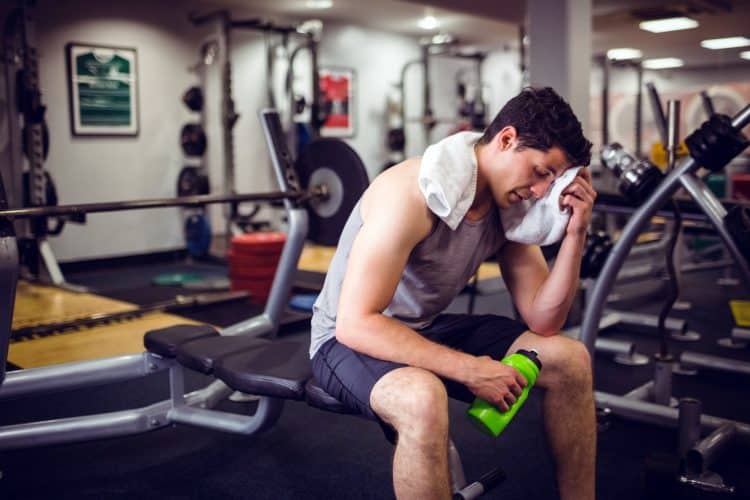As a strength & conditioning coach in NCAA Division One Athletics and competitive Functional Fitness over the last 10 years and working as a licensed Physical Therapist, I have learned an undeniable truth: when it comes to training, recovery is where the magic happens. After an intense workout, your body adapts and improves for the next training session.
Ever hit bench press on a Monday, and then the following Monday, you can do a few more reps at the same weight or use more weight for the same number of reps? This is adaptation taking place at the level of the nervous system and muscles.
Getting the most out of your workouts and seeing the most significant gains possible in your performance and aesthetics depends on how much and how quickly you can recover between sessions.
Rest days are vitally important for this, but you could do more to hasten the recovery process and put you in the best position possible to train hard, recover, and then return ready for more.
One of these recovery-enhancing modalities includes using water immersion to kickstart recovery immediately after your training session. However, there are conflicting opinions on which temperature is right for you post-workout to enhance your recovery. Some sources cite that cold water immersion is best, while others swear by hot water immersion.
In this guide, we will dive into the concepts around recovery and then explore the pros and cons of cold and hot water immersion so that you can decide what is best for you.
Level Up Your Fitness: Join our 💪 strong community in Fitness Volt Newsletter. Get daily inspiration, expert-backed workouts, nutrition tips, the latest in strength sports, and the support you need to reach your goals. Subscribe for free!
This way, you can bounce back from training faster than ever and keep your training intensity as high as possible.
The Importance of Recovery
Most people have heard or been told that recovery is essential. But, you may have yet to consider why this is the case. Recovery is just as important or even more important than the actual training you do in the gym because, without it, you will likely remain on a hamster wheel of progress.
You have likely seen the guy or girl in the gym who never seems to improve, always seems stressed out, looks like they have not slept in weeks, and has poor nutrition and lifestyle habits. This person is likely not recovering from their sessions and, therefore, cannot scaffold their training sessions and see progress over time.
If you want to get off the hamster wheel of progress and start seeing results from your workouts, then prioritizing your recovery is an absolute must.
The Science of Recovery
When you train, there is a short-term decrease in your performance levels because you have broken down muscle, depleted energy stores, and exhausted your energy systems. But with great sleep, nutrition, and rest, the body bounces back to baseline, and if the training stimulus and recovery are adequate, that baseline rises for the next session.
The “Stimulus Adaptation Recovery Curve” depicts this process. The curve shows your recovery at a baseline level, and with training, this baseline drops below what you began with, but with optimal recovery, you return to baseline and then “super compensate” beyond your initial baseline level.
Each activity you do in training will have its own SRA curve. Although it is nearly impossible to quantify this value, you can determine relative SRA curves between activities based on how strenuous they are.
A challenging training session that produces large amounts of lactic acid, is high volume, or uses heavyweights will have a much longer curve. You will need more time to recover to baseline from such a training session than a workout that is mainly technique-based.
Technique-based lifting would be like an Olympic weightlifter at the gym intending to polish their movements but not push their limits. With technique training sessions, the SRA curve and time back to baseline is much shorter, so getting back to full recovery is much quicker.
This is why sports like golf can be played every day because they are mainly technique-based. Yet a football player usually needs a whole week to return to being game-ready. It is no different for the average person who loves hitting it hard in the gym.
You must focus on your recovery to maximize your gains when you train hard. If you are preparing for sport, the person who can recover better and faster in training and between events usually comes out on top.
Recovery Modalities
If you are looking to enhance your recovery, there is likely a product or service that claims to do it for you.
There are several different kinds of recovery modalities in the market today. These can range from pneumatic boots and saunas to manual techniques like massage and devices such as Transcutaneous Electrical Nerve Stimulation (TENS) units.
One of the most researched methods of enhancing recovery is using water immersion in an ice bath or simply with showers post-training. The research on which temperature is best is conflicting with both methods showing positive benefits depending on which study you read.
However, there is one clear winner in my eyes. But first, let’s review the benefits of both hot and cold showers.
The Case For Cold Showers
The most common method of water therapy to improve recovery is cold water. At its most basic level, training produces a great deal of heat in the body, which can also be a source of fatigue if not managed appropriately through the sweating process. (1)
Thus, it makes sense that trainees and athletes alike will want to immediately get into a cold shower to cool themselves off from a challenging workout. But there is more to a cold shower post-workout than simply being refreshing.
Level Up Your Fitness: Join our 💪 strong community in Fitness Volt Newsletter. Get daily inspiration, expert-backed workouts, nutrition tips, the latest in strength sports, and the support you need to reach your goals. Subscribe for free!
Decreased Inflammation
The use of cold temperatures on inflamed joints, either after an injury or surgery, has been done for years. The concept behind using cold temperatures to decrease inflammation in the body stems from vasoconstriction or narrowing of the blood vessels, which prevents increased inflammatory substances from flooding into swollen joints.
This concept holds with cold showers post-exercise as joints may become inflamed due to everyday occurrences in heavy training where joint impact is high. The cold shower can have a global vasoconstrictive effect and help decrease inflammation in sore joints.
A cold shower may also have a pain-alleviating effect on the joints and muscles. This numbing effect decreases pain perception and indirectly reduces the inflammatory response.
Decreased Delayed Onset Muscle Soreness (DOMS)
Delayed onset muscle soreness or “DOMS” is a phenomenon in training that can negatively impact your ability to train consistently. DOMS is characterized as pain and stiffness that occurs in the days following exercise and peaks at around 48 hours post-workout. (2)
This can occur if you are just getting started or back into training. As well as if you have been training for some time now and have recently changed your exercise selection or advanced your training in some way, such as increasing the weight you use or the repetitions you have for that training session.
Some soreness is expected after training, but it can be problematic if it is severe. Cold water therapy has been shown to decrease DOMS in the days post-workout. (2) This is in response to the effect that freezing temperatures have on the temperature of the tissues and the nerve conduction speed of pain fibers. (2)
When the nerve conduction speed is slowed, pain signals to the brain are reduced, creating a pain-relieving effect. (2)
Improved Circulation
Improving circulation throughout the body may seem counterintuitive based on what I have mentioned above regarding blood flow restriction with cold water therapy. Cold temperature causes vasoconstriction and limits blood flow around the body. (3) However, it improves circulation through a rebound effect once the mean temperature is removed. (3)
When the body’s vessels become unrestricted and return to their standard diameter, there is a rebound of increased blood flow to account for and make up for this, improving the rate at which blood is circulated throughout the body. (3)
This is important for recovery as the abundance of blood flow to the body’s muscles, organs, and joints brings nutrition and other recovery substrates to the area to replenish what was used in the workout. These include carbohydrates, amino acids, and electrolytes like sodium and potassium.
The Case For Hot Showers
Although it may seem counterintuitive to get into a hot shower after working up a sweat and increasing your core temperature during your workout, there are some benefits to hot showers post-workout. Also, some people may not tolerate cold temperatures very well; thus, hot showers will be a better option for them to enhance their recovery.
Heat Acclimation

This is probably the most significant benefit of taking a hot shower post-workout if you work, train in, or compete in climates where the temperature is warm, such as military personnel, athletes, or first responders. An inability to regulate your core body temperature can be a source of fatigue during training and competition. (4)
This is because exercising in hot climates creates an added burden on your system that can negatively affect brain function, ventilation rate, and muscle metabolism if you are not well adapted to it. (1)
Utilizing hot showers after workouts can help your body adapt to these hot climates and improve your performance in training or competition. (4) In doing so, you can train at higher intensities, and the longer and more frequently you can sustain high-intensity training, the higher your performance will climb.
For those competing, especially in sports where your ability to ward off fatigue determines the champion, like Track & Field, CrossFit, and Cycling, the person who can keep their system more relaxed for longer will typically have the best chance of winning.
Increased Blood Flow
Hot water showers may help recovery post-workout as the warm temperatures allow for relaxing the muscles of the blood vessel walls, allowing them to increase in diameter (vasodilate) to allow for increased blood flow to the muscles. As this occurs, more blood can pass through the vessels and reach the muscles faster, effectively bringing the nutrition the muscles need to regenerate and recover quickly. (5)
The enhanced blood flow also facilitates the removal of waste products produced during exercise, like lactic acid, ammonia, and carbon dioxide (CO2), from the muscle tissues. Each of these is removed via the blood and then either converted into a new substance to be used as fuel (lactic acid) or excreted in the urine (ammonia) or the lungs (CO2).
Acceleration of Metabolic Processes
Another benefit of hot showers post-workout is what the warm temperatures can do at the cellular level inside the muscle tissue. After your training session, a host of metabolic processes and signaling pathways occur to kickstart the recovery process. (6)
These include several anabolic processes, such as protein synthesis, that work to repair damaged muscle tissue and build new tissue in preparation for the next session. According to several studies, warm temperatures after training can directly upregulate these processes via increased cell signaling. (6)
Are Hot Showers or Cold Showers Better Post Workout?
As you can see, there are arguments to be made for both hot and cold showers. However, according to the available research, cold showers will most profoundly affect your ability to recover and prepare for your next training session.
Although several studies cite the benefits of hot water immersion post-exercise, many did not show any positive effect on recovery. Therefore, the impact of hot water immersion on recovery post-exercise is unclear. (7)
Thus, if you are looking for a way to hack your recovery and enhance the gains you can make from your training, I would opt for a cold shower post-workout.
If, however, you cannot tolerate cold temperatures well, such as those living with Reynaud’s disease, where the vessels of the body constrict excessively in response to cold, then hot showers can still provide some benefit.
You now have another method in your toolbox to optimize your recovery and continue training hard. So take what you know now, start incorporating water therapy into your post-workout routine, and watch your gains skyrocket.
References
- Nybo, L., Rasmussen, P., & Sawka, M. N. (2014). Performance in the heat-physiological factors of importance for hyperthermia-induced fatigue. Comprehensive Physiology, 4(2), 657–689.
- Wang, Y., Li, S., Zhang, Y., Chen, Y., Yan, F., Han, L., & Ma, Y. (2021). Heat and cold therapy reduce pain in patients with delayed onset muscle soreness: A systematic review and meta-analysis of 32 randomized controlled trials. Physical therapy in sport : official journal of the Association of Chartered Physiotherapists in Sports Medicine, 48, 177–187.
- Yeung, S. S., Ting, K. H., Hon, M., Fung, N. Y., Choi, M. M., Cheng, J. C., & Yeung, E. W. (2016). Effects of Cold Water Immersion on Muscle Oxygenation During Repeated Bouts of Fatiguing Exercise: A Randomized Controlled Study. Medicine, 95(1), e2455.
- Zurawlew, M. J., Mee, J. A., & Walsh, N. P. (2019). Post-exercise hot water immersion elicits heat acclimation adaptations that are retained for at least two weeks. Frontiers in physiology, 10, 1080.
- Wilcock, I. M., Cronin, J. B., & Hing, W. A. (2006). Physiological response to water immersion: a method for sport recovery?. Sports medicine, 36, 747-765.
- Jackman, J. S., Bell, P. G., Van Someren, K., Gondek, M. B., Hills, F. A., Wilson, L. J., & Cockburn, E. (2023). Effect of hot water immersion on acute physiological responses following resistance exercise. Frontiers in Physiology, 14.
- Versey, N. G., Halson, S. L., & Dawson, B. T. (2013). Water immersion recovery for athletes: effect on exercise performance and practical recommendations. Sports medicine, 43, 1101-1130.











Is there anything to research that shows that cold water immersion immediately following a workout may blunt hypertrophy and negatively affect strength?
https://www.ncbi.nlm.nih.gov/pmc/articles/PMC4594298/
Hello Darren, Great insightful question about the effects of cold water immersion on muscle hypertrophy and strength gains. The Recent research, including a significant study published in the Journal of Physiology, sheds light on this very topic.
The study you referenced investigates the impact of regular CWI on strength training adaptations. It found that CWI can attenuate gains in muscle mass and strength. This is attributed to CWI’s influence on key cellular and molecular mechanisms fundamental to muscle adaptation post-exercise. Specifically, CWI seems to interfere with the activity of satellite cells and kinases in the mTOR pathway during recovery from strength exercise. Satellite cells are essential for muscle repair and hypertrophy, and the mTOR pathway is crucial for muscle protein synthesis. By impacting these elements, CWI might limit the body’s ability to fully capitalize on the muscle-building benefits of strength training.
Moreover, the research suggests that the decrease in muscle blood flow and temperature reduction associated with CWI may be contributing factors. These changes can potentially affect the delivery of nutrients to muscles and the activation of genes and proteins involved in muscle growth and repair.
In conclusion, while CWI might offer immediate benefits like reduced muscle soreness and perceived recovery enhancement, its long-term impact on muscle adaptation may not align with the goals of individuals seeking to maximize strength and hypertrophy gains from their training. As with all recovery strategies, it’s important to consider both the short-term and long-term effects on your body and training goals.